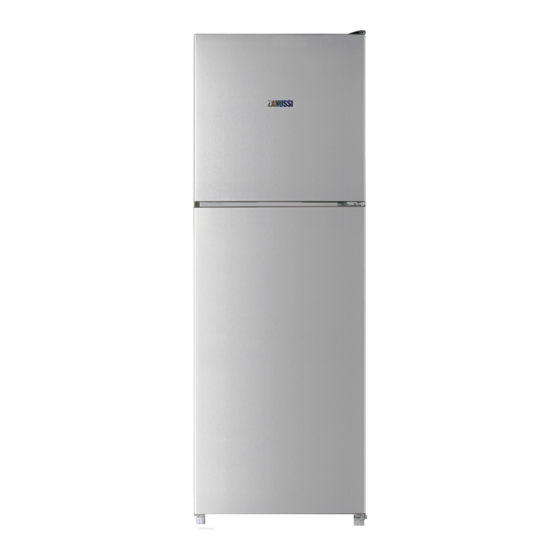Zanussi ZTB2500A-A Manuale di istruzioni - Pagina 6
Sfoglia online o scarica il pdf Manuale di istruzioni per Frigorifero Zanussi ZTB2500A-A. Zanussi ZTB2500A-A 8.

2.
If you have a power outage notice in advance:
1)
Please an hour in advance will be temperature control stalls transferred to a strong cold position, so that the
refrigerator fully frozen. (Note that this time do not store new food!) To be restored after the timely supply of
temperature control gear to the original location.
2)
You can also make some ice, with a watertight container, and put it in the upper part of the refrigerator. So that it is
necessary to extend the time for fresh food to be deposited.
Preparations for refrigerating
1.
Leave cooked food to cool completely.
2.
Chill food in a Fridge before freezing if possible.
3.
Consider how you want to cook the food before freezing it.
4.
Don't freeze food in metal containers as you may want to microwave it straight from the refrigerator.
5.
Use special refrigerator bags available from supermarkets, refrigerator film, polythene bags, plastic containers,
aluminum foil for acidic foods (such as citrus fruits). Do not use thin cling film or glass. Do not use used food
containers (unless cleaned thoroughly first).
6.
Exclude as much air from the container as possible. You could buy a special vacuum pump which sucks excessive
air out of the packaging.
7.
Leave a small amount of "air space" when freezing liquids, to allow for expansion.
8.
You can use the space in the refrigerator most efficiently if you freeze liquids (or solids with liquids, such as stew) in
square blocks. This is known as "performing" Pour the liquid into a polythene bag which is inside a square sided
container. Freeze it like this, then remove it from the container and seal the bag.
Tips for shopping for frozen foods
1.
When you are buying frozen food, look at the Storage Guidelines on the packaging. You will be able to
store each item of frozen food for the period shown against the star rating. This is usually the period
stated as "Best, Before", found on the front of the packaging.
2.
Check the temperature of the frozen food cabinet in the shop where you buy your frozen foods.
3.
Make sure the frozen food package is in perfect condition.
4.
Always buy frozen products last on your shopping trip or visit to the supermarket.
5.
Try to keep frozen food together whilst shopping, and on the journey home as this will help to keep the
food cooler.
6.
Don't buy frozen food unless you can freeze it straight away. Special insulated bags can be bought from most
supermarkets and hardware shops. These keep frozen food cold for longer.
7.
For some foods, thawing before cooking is unnecessary. Vegetables and pasta can be added directly to boiling water
or steam cooked. Frozen sauces and soups can be put into a saucepan and heated gently until thawed.
8.
Use quality food and handle it as little as possible. Freeze food in small quantities, it freezes faster, takes less time to
thaw and enables you to eat it in the quantity you need.
9.
First, estimate the amount of food you will be freezing. If you are freezing large amounts of fresh food, remember to
turn the control dial to the low temperature range. This will lower the temperature in the Freezer, freezing your food
quicker and helping to keep the goodness in. However, you should do this sparingly to conserve energy.
Defrosting
This appliance is designed as automatic defrosting, no need to defrost by hand.
Moving the Refrigerator
Location
Do not place your Refrigerator near a heat source, e.g. cooker, boiler or radiator. Also avoid direct sunlight in out-buildings
or sun lounges.
Leveling the Refrigerator
Make sure the Refrigerator is level. Use the rotating leveling feet at the front. If the Refrigerator is not level, the doors and
magnetic seal alignments will be affected and may cause your Refrigerator to work incorrectly.
After the Refrigerator is in place, it can be used after 4 hours. This allows time for the coolant to settle.
Installation
Don't cover or block the vents or grilles of your appliance.
If you're not at home for a long time
If the appliance will not be used for several months, turn off the refrigerator first and then unplug the unit from the wall
outlet.
Remove all the food.
Clean and dry the interior thoroughly. To prevent odor and mold growth, leave the door open slightly: blocking it
open if necessary or have the door removed.
Keep the cleaned fridge in a dry, ventilated place away from the heat source, where the fridge is placed smoothly
and do not place heavy objects on top of the fridge.
Use extreme caution in the case of children. The unit should not be accessible to child's play.
Save energy
1.
Install the refrigerator in the coolest part of the room, out of direct sunlight and away from heating ducts or registers.
Do not place the refrigerator next to heat-producing appliances such as a range, oven or dishwasher.
2.
The refrigerator door should remain open only as long as necessary; do not place hot food inside the refrigerator.
3.
Organize the refrigerator to reduce door openings. Remove as many items as needed
door as soon as possible.
4.
The refrigerator door should be properly closed to avoid increased energy consumption, and the formation of excess
ice and / or condensation inside.
5.
Constantly circulating cold air keeps the temperature homogenous inside the refrigerator. For this reason, it is
important to properly distribute the food, to facilitate the flow of air.
Classified as Internal
6
at one time and close the
